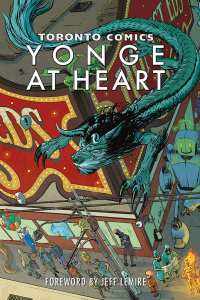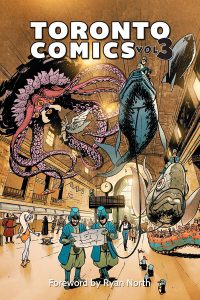Urk. I’ve done it. I’ve ordered a Cintiq.
Tag Archive for kamics
Clip Studio Tutorial Video
I think I first encountered this video at least a year ago. Maybe two. It’s one of a series that Smith Micro Graphics made to raise the profile of Manga Studio (now called Clip Studio Paint and Manga Studio Ex is now called Clip Studio Pro).
The presenter is an artist by the name of D.M. Cumbo, who has been working on an illustrated story called Dreamside. At about the time that Smith Micro released the video, D.M. Cumbo was also making a number of videos about different Manga Studio techniques, but he’s gone a bit quiet on that front lately.
Cumbo’s art really stands out to me because of the vibrancy of colour that he achieves. In a later video, he says that vibrancy is really all about contrast, and that picking colours that contrast well is the key to creating vibrant images. He also really pushes the idea of bounce-back lighting in a number of his videos: he says that things really look “in the environment” when you can see the colours of the environment reflecting back on a figure or object in that environment.
There are three techniques that Cumbo describes in this video that interest me:
Toronto Comics: Yonge at Heart
This week, the Shuster Award nominations were announced, and for the third year in a row, the Toronto Comics anthology has been nominated for the Gene Day Award for self-published comics. We’ve lost out the last two years, and I don’t really expect this year to go any differently but, as they say, it’s an honour to be nominated.
 Because of eligibility date requirements, the nomination was for Volume 3, which came out in 2016. But it’s 2017 now, and there’s a fourth volume. This year, the editors dispensed with the “Volume X” subtitle, and gave the book its own swanky subtitle: Yonge at Heart! This year’s book is a bit smaller (in a “number of pages” sense) than previous years, but what it lacks in pages it makes up for with vibrant colour! And, boy howdy, does that colour make for some gorgeous pages.
Because of eligibility date requirements, the nomination was for Volume 3, which came out in 2016. But it’s 2017 now, and there’s a fourth volume. This year, the editors dispensed with the “Volume X” subtitle, and gave the book its own swanky subtitle: Yonge at Heart! This year’s book is a bit smaller (in a “number of pages” sense) than previous years, but what it lacks in pages it makes up for with vibrant colour! And, boy howdy, does that colour make for some gorgeous pages.
She Comes in Colours Everywhere.
I’m continuing to pour a lot of my creative energy into comics. I’ve had a few things going on in that world.
 First up, I’ve taken part in the third volume of Toronto Comics (the book seems to have dropped the “Anthology” part of the name). I wrote a story this year — “Lofty Aspirations” — but didn’t draw it. Instead, it was illustrated by Xan Grey, an amazingly talented artist, who’s been in the last two anthologies.
First up, I’ve taken part in the third volume of Toronto Comics (the book seems to have dropped the “Anthology” part of the name). I wrote a story this year — “Lofty Aspirations” — but didn’t draw it. Instead, it was illustrated by Xan Grey, an amazingly talented artist, who’s been in the last two anthologies.
Military Uniforms
Do any of my friends understand military uniforms? I’m especially interested in WW2-era US Army uniforms, for a comic project.
There are some details that I haven’t been able to make sense of and I’d love some insights.
Nomination
The first volume of the Toronto Comics anthology has been nominated for a Gene Day Award for self-published (Canadian?) comic.
Scrivenering and Scripts
 One of the things that Ty taught in his writing class was story maps. Basically, (in the form he was teaching us) they’re a simple device for planning a basic comic script. Obviously, story maps aren’t unique to comic writing, but Ty’s technique for using them is pretty specific to mainstream comics publishing.
One of the things that Ty taught in his writing class was story maps. Basically, (in the form he was teaching us) they’re a simple device for planning a basic comic script. Obviously, story maps aren’t unique to comic writing, but Ty’s technique for using them is pretty specific to mainstream comics publishing.
Here’s an example of a story map that he filled out — I’ve seen this particular example used to provide a visual aid for his Writing Comics course. He also hands out blank versions in his class — I scanned one and redrew it in Illustrator because I like doing stuff electronically.
Comics and Me
So, j00j suggested that I write something about comics. That’s a big topic for me, and has several dimensions. I mean there’s the whole “my history reading comics” angle, and the “comics I like” angle, and the “what tools am I using to make comics?” angle and even the “what comics am I working on?” angle.
So I’m gonna try all of that. But probably not all in one post. First, history.
 I’ve said before that the house I grew up in didn’t really have many books. My parents weren’t readers, and I didn’t start reading until they taught it in school. I attended Rosedale Public School for nine years (kindergarten to grade 8 school). There wasn’t much distinctive about Rosedale. It was built in the mid-fifties, and had two classes of each grade. The classes for grades two and three laid out in an open concept in an area that surrounded the school’s library (although we never called it a library; it was apparently a “resource centre”).
I’ve said before that the house I grew up in didn’t really have many books. My parents weren’t readers, and I didn’t start reading until they taught it in school. I attended Rosedale Public School for nine years (kindergarten to grade 8 school). There wasn’t much distinctive about Rosedale. It was built in the mid-fifties, and had two classes of each grade. The classes for grades two and three laid out in an open concept in an area that surrounded the school’s library (although we never called it a library; it was apparently a “resource centre”).
Anyway, in grade three (1974/1975), the teachers introduced a reading period, and encouraged kids to bring books to read, and to show them off to other students. And that was how I was first introduced to comics. Several other kids had comic books. Popular books at the time included Richie Rich and Baby Huey and Hot Stuff, the Little Devil, but I was most fascinated by one comic in particular: Justice League of America #100.

